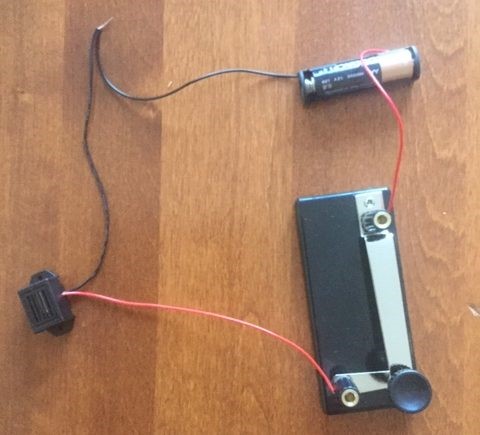| By Dan Romanchik, KB6NU |
|---|
| W7SKY HOMEPAGE |
|---|
| DECEMBER 2019 EDITION |
|---|
Everything should be made as simple as possible,
but not simpler
By Dan Romanchik, KB6NU
"Everything should be made as simple as possible,
but not simpler" is a quote attributed to Albert Einstein
(https://quotationcelebration.wordpress.com/2017/01/07/everything-should-be-made-as-simple-as-possible-but-not-simpler-albert-einstein/comment-page-1/).
Here's one way to apply this principle in amateur radio, specifically to
code practice oscillators.
A week ago, my friend, Paul emailed me:
“I am planning on teaching a two-hour introduction
to Morse code to 14 girls ages 8 to 9
[[Paul's granddaughteris a Girl Scout.]]. I plan on having the
girls build a code practice device. I need your help in selecting a low cost
buzzer and battery holder. Please take a look around and see would you can
find. I would like to limit the power to one or two AA batteries.”
I replied that I'd be happy to help him with the
demonstration, and offered the following advice:
“A while back, I built the QRPGuys’ K7QO Code
Practice Oscillator (https://qrpguys.com/k7qo-code-practice-oscillator). It
uses a CR2032 coin battery.
“Unfortunately, they don’t sell it anymore, but the
assembly manual is still online
(https://qrpguys.com/wp-content/uploads/2017/03/cpo_assy_012616.pdf). The
assembly manual doesn’t call out specific parts, but here are some Amazon
SKUs:
·
B00J4BK0NS, Black 3V Electromagnetic Type
Piezo Buzzer, 20 pcs/$6.58
·
B06XF3K4NP, Coin Cell Button Battery Holder,
30 pcs/$9
·
B008SNZUYC, 3 Pin PCB Mount Female 3.5mm
Stereo Jack, 10 pcs/$5.40
·
B071RMD6FD, 1/8" 3.5mm Stereo Male Connector,
10 pcs/$7
“Batteries are available at the dollar store for
about 30 cents each. So, you could do the whole thing for less than $5 for
sure, even with a printed circuit board, which I would suggest that we do.
Heck, if you ask nicely, the QRPGuys might even give us the artwork, or even
better, have some boards still in stock. Even if they have neither, you
should be able to get the boards in plenty of time.”
Later that day, Paul replied:
Thanks, Dan, for the information and making yourself
available to help. I am just going to use a buzzer, key, and battery. The
buzzer has a frequency of 400 Hz.
·
https://www.xump.com/science/Buzzer-Leads15V.cfm
·
https://www.xump.com/science/ContactKeySwitch.cfm
·
https://www.xump.com/science/Single-AA-Battery-Holder.cfm
And this morning, he sent me this photo, noting,
“FYI. Also sounds great.”

I think that this is as good an example of
"Everything should be made as simple as possible, but not simpler" as there
can be. I've volunteered to help Paul with his class. That will be fun, too.
=============================

APRIL 2019 > PART 1
| Dan Romanchik, KB6NU, is
the author of the KB6NU amateur radio blog (KB6NU.Com), the “No
Nonsense” amateur radio license study guides (KB6NU.Com/study-guides/),
and one of the hosts of the No Nonsense Amateur Radio Podcast
(NoNonsenseAmateurRadio.Com). When he's not wondering when robots are
going to take over the world, he likes to (manually) operate CW on the
HF bands. |
|---|
